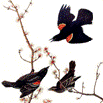Center, Internet, Wildlife Damage Management

Bird Control Seminars Proceedings
Document Type
Article
Date of this Version
November 1976
Abstract
One of the few processes of an avian population that presents the opportunity to collect sensitive information about the performance of that population is growth rates of young throughout the brooding period. Growth rate data are sensitive to many conditions of the breeding cycle: proximate influences, such as food availability and weather (Francis, et al., in prep.), and ultimate factors, such as species-specific characteristics, (Ricklefs, 1968). Additionally, the measurements themselves can be obtained with precision. The ability to make such detailed observations is extremely useful and is not always possible for other population parameters, such as determining life table data. Ricklefs (1967) gave considerable attention to this subject and elaborated techniques for making comparisons of growth rates of young of various bird species. From these, he and others (Fretwell and Bowen, 1974) have gone on to make several predictions about the status of various species and their populations in nature (Ricklefs, 1968, 1972, 1976).

